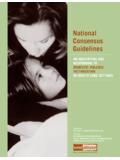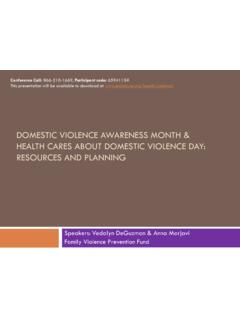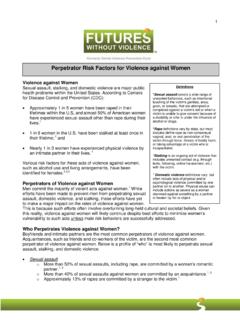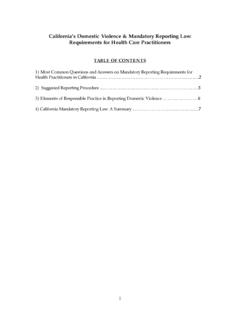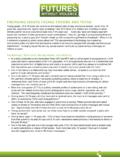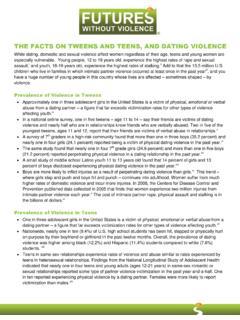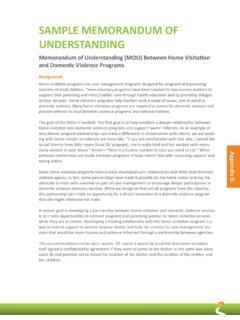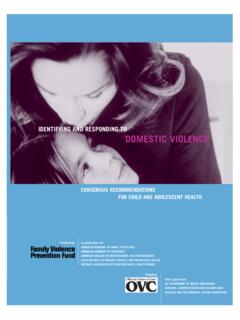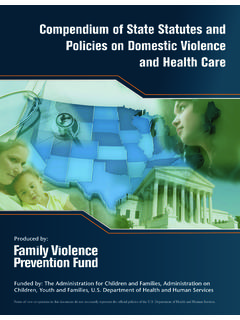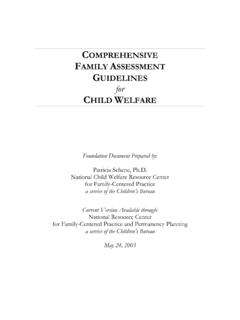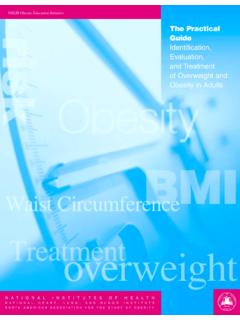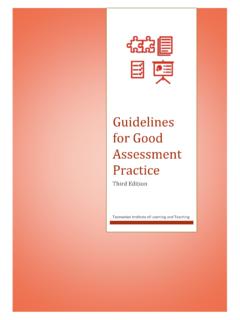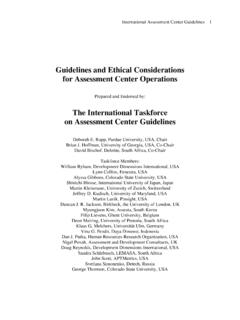Transcription of Guidelines for Clinical Assessment and Intervention
1 Warm Springs Health and Wellness Center Guidelines for Clinical Assessment and Intervention on Domestic Violence 1 Guidelines for Clinical Assessment and Intervention Introduction: Physical and sexual violence against women is a public health problem of epidemic proportions. 3-4 million women in the United States are battered by their former or current partners annually. These numbers represent only those documented cases. Incidence is likely much higher as many never seek assistance. It is estimated that 30% of female murder victims in the United States are killed by a current or former partner. In addition to the physical and psychological issues related to domestic violence, it has been shown that children raised in these situations are at risk to continue this cycle of violence whether it is domestic or non-domestic.
2 Alcohol and drug use and dependence are also increased among both the victims and the children involved in these situations. Domestic violence occurs in every sector of society and among all races. It occurs in both heterosexual and homosexual relationships. The US Department of Justice estimates that 95% of reported assaults on spouses or ex-spouses are committed by men against women. The Warm Springs Community is not immune to domestic violence and it plays a tremendous role in the health of this and any community, therefore we must place identification and Intervention of this issue in the foremost part of our mind and take it as a very serious concern. Purpose: Medical practitioners are often the first or the only professionals to come into contact with individuals in abusive situations.
3 We have a unique responsibility and opportunity to intervene. Traditionally health care practitioners are not instructed in such Intervention or in how to respond appropriately when domestic violence affects their patient s life. The purpose of this protocol is to aid in identification, treatment and Intervention in such situations. Since 1992 the Joint Commission Accreditation of Health Care Organizations has required that all accredited hospitals implement policies and procedures in the emergency and ambulatory care facilities for identifying and treating and referring victims of domestic abuse. These standards include educational programs for staff in domestic violence. This protocol is intended to assist medical professionals in complying with these standards and thus improving service to this group of patients.
4 Training for health care providers has proven to be very effective in implementing and improving the quality of health care given to battered patients. Our policies will include procedures for identifying and documenting partner abuse, providing patient information about community resources and educating staff on handling these cases. As the great majority of victims are female, they will be referred to a she for the purposes of this document. We do recognize that violence occurs female to male and in same sex relationships. The same Guidelines apply in these cases. Definition: Domestic Violence is a pattern of assaultive and coercive behaviors, including physical, sexual and psychological attacks, as well as economic coercion that adults and adolescents use in effort to control their intimate partners.
5 Guiding Principles: 1. Treat patients with dignity, respect, and compassion and with sensitivity to age, culture, ethnicity and sexual orientation, while recognizing that domestic violence is unacceptable in any relationship. 2. Recognize that the process of leaving a violent relationship is often a long and gradual one. 3. Attempt to engage patients in long-term continuity of care within the health care system, in order to support them through the process of attaining greater safety and control in their lives. 4. Regard the safety of victims and their children as priority. Warm Springs Health and Wellness Center Guidelines for Clinical Assessment and Intervention on Domestic Violence 2 I. Screening. Domestic violence and it s sequel are present in numbers to justify routine screening.
6 Early recognition and Intervention can significantly reduce the morbidity and mortality that results from violence in the home. A woman may not initially recognize herself as battered ; therefore the medical professional should routinely ask all women direct specific questions about abuse. A. Who to Screen. 1. All women and adolescent girls in a primary care or inpatient setting 2. Men and adolescent boys who present with symptoms or signs of domestic violence. 3. Children - Screen female caregiver/parents or caregivers known to be in a same sex relationship who accompany their children 4. Any patients who present with Clinical findings that may indicate Alcohol or drug abuse Injury inconsistent with patients explanation Repeated use of the ER Eating disorders Chronic pain syndromes Injury during pregnancy Prior history of trauma vague psychosomatic complaints Multiple injuries in various stages of healing A partner who will not leave the exam room Injury to the head, neck, torso, genitals, breast or abdomen Delay between onset of injury and seeking care Psychological distress (suicidal, depression, anxiety or sleep disorders) B.
7 When to Screen 1. Women and adolescent girls- screening will be done for all presenting for At new patient visits Every six months At disclosure of a new intimate relationship. 2. Screening in pregnancy will At the first prenatal visit At first prenatal visit and at least once during each trimester of pregnancy during prenatal care During post- partum visits 3. Pediatric visit - Female caregiver/parents who accompany their children will be During new pediatric patient visits At each well child visit during the first year of life and then once per year at well child visits At disclosure of a new intimate relationship 4. Pediatric visit-female or male caregiver/parents known to be in same sex relationships who accompany their children will be During new pediatric patient visits At each well child visit during the first year of life and then once per year at well child visits At disclosure of a new intimate relationship 5.
8 Men will be screened on an as indicated basis. 6. Screening will also occur on an as indicated basis per the suggestions in section Warm Springs Health and Wellness Center Guidelines for Clinical Assessment and Intervention on Domestic Violence 3 C. How to Screen 1. Screen in a safe environment. Separate any accompanying persons from the patient when screening for domestic violence. Ask the patient about domestic violence in a private place. If this cannot be done postpone screening for a follow up visit. 2. Use your own words in a non-threatening, non-judgmental way. Domestic Violence is so common I ask all my female patients about abuse in the home 3. Use questions that are direct, specific and easy to understand.
9 Do you feel safe in your current relationship? Have you or your children ever been threatened or abused (physically, sexually or emotionally) by your partner? Is there a partner from a previous relationship who is making you feel unsafe? 4. Discuss with patients the confidentiality of these questions and the mandatory reporting of child abuse. 5. The WSH&WC Screening Questionnaire may be used when children older than 2 years old are in the room or in the treatment room were privacy may be of concern. Remember that the patient may deny abuse if she is not ready to deal with the situation or is in denial. Even if you are certain of an abusive situation do not force the issue with her. The decision to leave or take action needs to be hers.
10 D. Document that screening for domestic violence was done. Document under the education section of PCC+ form circling the appropriate response DV P (positive), N (negative) or S (suspect) Document as Personal History Phx Domestic Violence Screening negative 8/8/99 For positive screens or acute instances of abuse, document in the health summary. EX. WSP 6 Adult abuse Emotional, physical, sexual WSP hospitalized 4/98 fractured jaw WSP Victims Assistance referral 5/2/98 II.
